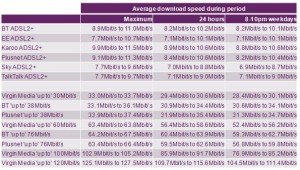Average UK Broadband Speed Continues To Rise
The research reveals that the average download speed of all superfast connections included in the report continued to increase, reaching 45.3Mbit/s in the six months to May 2013 (an increase of 0.7Mbit/s, or 2%).
Table Two: Average download speeds by ISP package5
These ranges reflect the average speeds that would be achieved 95 times out of 100 if the exercise was repeated with 100 sets of different panellists. If the range of two operators overlaps, then these operators offer comparable performance. These ranges are not a description of the range of speeds actually measured.

Ofcoms research also looks at upload speeds, which are particularly important to those consumers looking to share large files or use real-time video communications.
The research found that Plusnets up to 76Mbit/s service delivered the highest upload speeds of all the packages measured, averaging 16.8Mbit/s.6
Measuring speeds at peak times
The report contains analysis comparing average peak time speeds (weekdays from 8pm to 10pm) with maximum connection speeds (the maximum speed achieved by each connection during the month).
Download speeds often fall during peak busy periods when a large number of people are using their broadband connections at the same. This puts capacity constraints on ISPs networks known as contention.7
In May 2013, the UK average peak time download speed was 14.2Mbit/s, 88% of the average maximum speed. This compared to an average peak time speed of 11.8Mbit/s in November 2012, or 90% of the average maximum speed.
The most significant differences in speeds achieved at peak times occurred for superfast packages.
Urban and rural speed comparisons
Todays report outlines the differences between broadband speeds delivered in urban, suburban and rural areas.
Average actual download speeds for urban, suburban and rural areas have all increased in recent years
Although the research shows average speeds in urban (26.4Mbit/s) and suburban areas (17.9Mbit/s) to be highest, speeds in rural areas are increasing at a faster rate than elsewhere (by 69% since May 2012 and 141% since May 2011).
The gap between average download speeds in urban and rural areas has nonetheless widened from 9.5Mbit/s in May 2011 to 16.5Mbit/s in May 2013. This is due to the lower availability of superfast broadband services in rural areas compared to urban areas, and because ADSL broadband speeds are also generally slower in rural areas because the average line between the home and the nearest telephone exchange needs to be longer. While the gap between average urban and rural speeds is likely to widen in the short term, Ofcom expects that it will begin to decline over time, as the availability of superfast broadband increases in rural areas.
